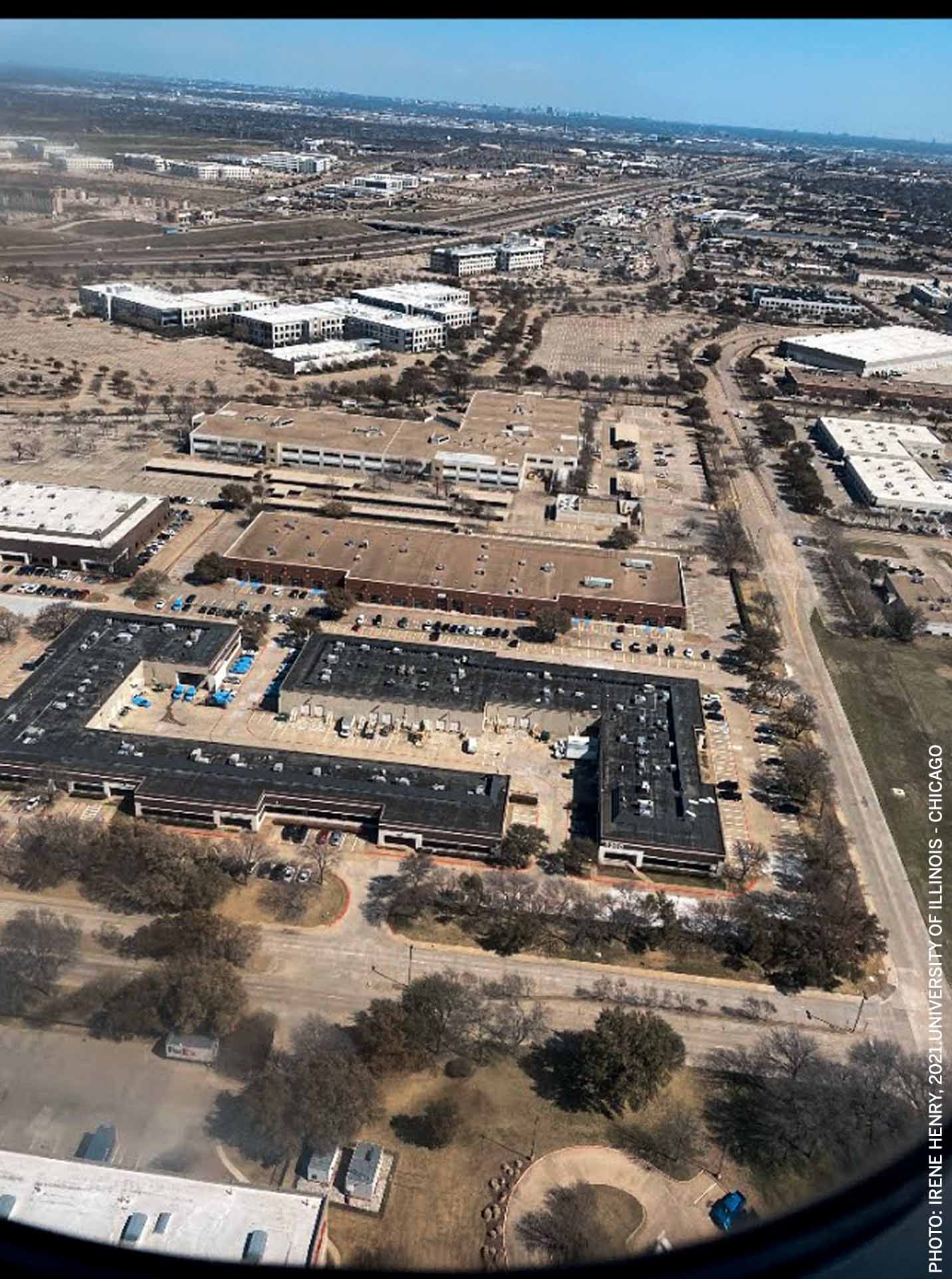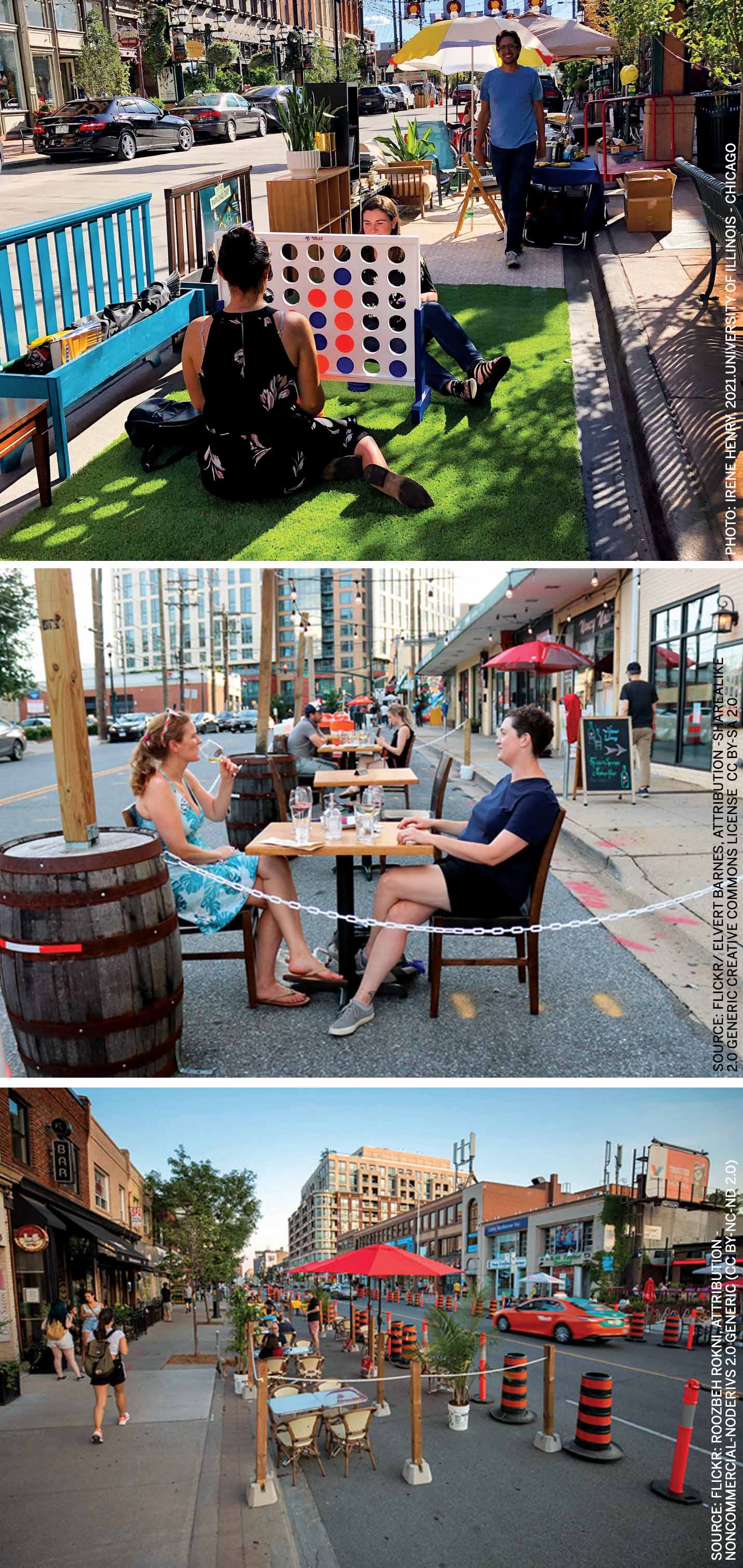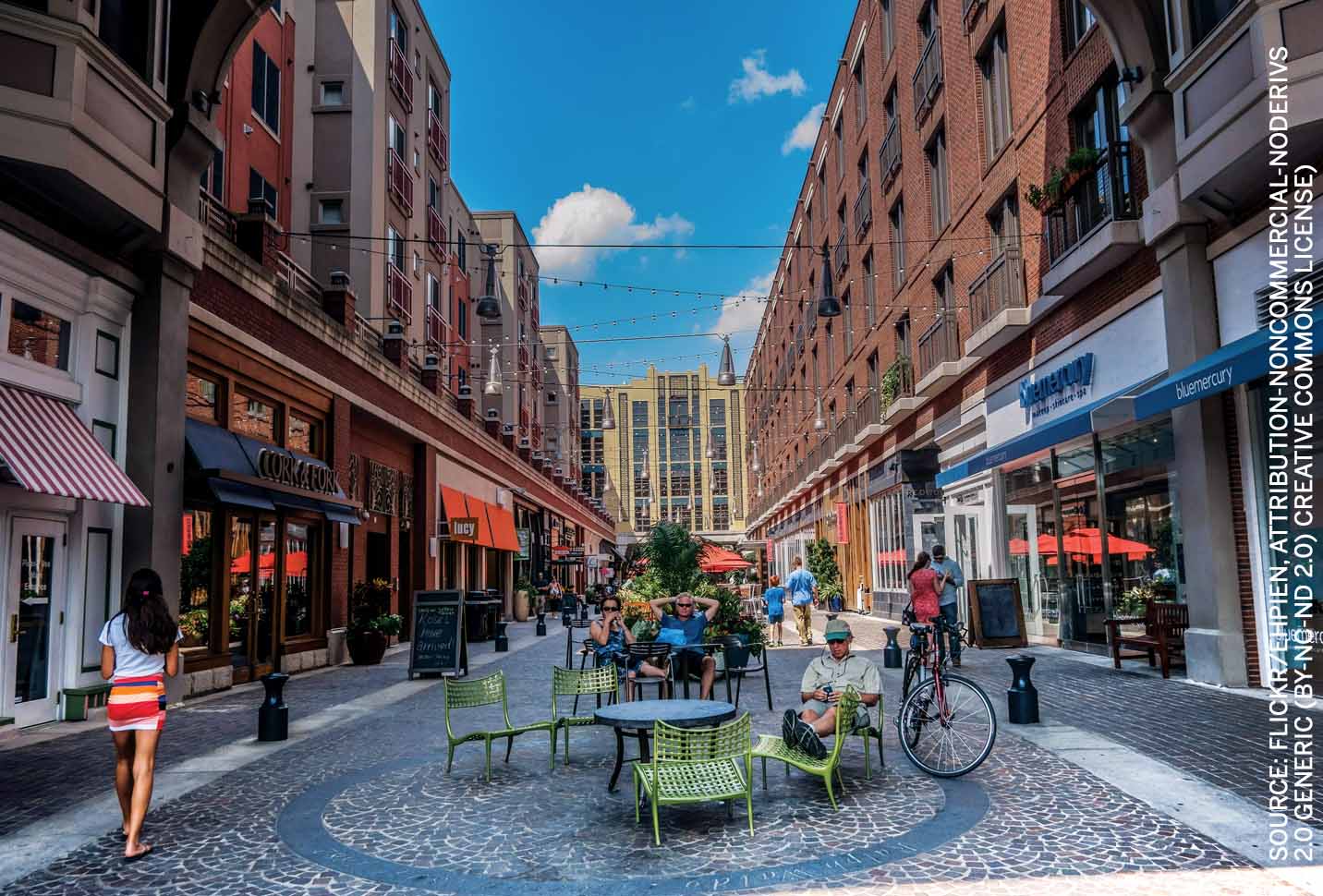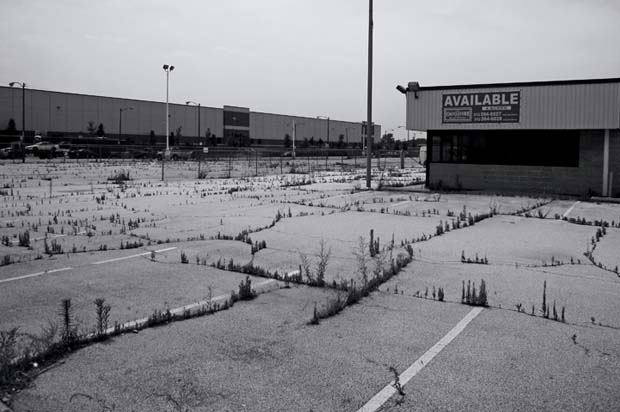A majority of land in cities within the United States is dedicated to streets, parking lots, garages, bridges and highways; this ubiquity of autopian infrastructure has led us to simply take its existence for granted. Perhaps no usage of car-oriented pavement is as conspicuous as the parking lot. The freedom of driving an autonomous vehicle comes with many tangible disadvantages in the form of insurance and tickets, but one that most residents of the United States frequently overlook is the chokehold that parking lots have on urban landscapes. Concrete smothers native green spaces and destroys the attraction of once dense, walkable urban streets with expansive land harbours for giant sports utility vehicles.
Ironically, many parking spaces are underutilised by cars as consumers transition to online retail and abandon traditional malls and strips. Vast lots, often covering dozens of acres, exist idly for cars while ignoring natural ecologies and human-scale needs. A drastic change in land use allocation has long been necessary, however, the effects of the Covid-19 pandemic have intensified the urgency. The inhalation of only a few virus particles has the potential to infect individuals, creating dangerous, difficult situations for the service industry and exacerbating existing crises of housing needs and lack of safe public spaces. Repurposing empty parking lots provides an opportunity to alleviate these issues.
In a country plagued by sprawling, automobile-dependent infrastructure, the parking lot maintains a depressing omnipresence
This essay explores ways of reclaiming dedicated parking spaces for more community-oriented needs ranging from the least to the most resource intensive. At the low end of the intensity scale, tactical urbanist techniques require little more than a few plucky individuals with creative ideas to reconfigure spaces through ‘Do It Yourself’ (D.I.Y.) initiatives. More financial resources can enable traditional infill projects, such as new urbanist developments focusing on walkable, mixed-use designs to create a more permanent physical metamorphosis on a parcel-level scale. The broadest modifications to land use emerge from policy changes that aim to transform an entire community’s relationship to parking and automobiles. These can include lifting parking space minimums, requiring lots to be shared with other land uses and charging for parking.

Parking Lot Land Use in North America
Experts estimate that the United States is home to between 105 million and 2 billion parking spots, with most estimates hovering around 500 million (Kimmelman, 2012). That is 3,590 square miles dedicated to idle, unoccupied vehicles. One study showed an average of eight parking spots for every person, with more pavement-heavy areas like Houston, Texas, boasting a whopping 30 per person (2012). In a country plagued by sprawling, automobile-dependent infrastructure, the parking lot maintains a depressing omnipresence. While dense urban areas are likely to offer street parking, some of which is metered or permitted to prevent overcrowding, the suburban parking lot is an entirely different beast. These often cover dozens of acres, sometimes taking up more space than the buildings and spaces they serve. The United States’ northern neighbour, Canada, is home to the world’s largest parking lot: the 20,000 parking spaces of West Edmonton Mall stretch over 73 acres. These concrete fields are welcoming to automobiles, buses and trucks, but create a decidedly unpleasant environment for pedestrians, public transit users and natural ecologies.
When first gaining prominence during the 1970s, the parking lot was associated with the convenience and freedom once tied to the car. The psychological ideals mirrored those of supermarkets: patrons could bathe in an abundance of choices! Yet many of the lots continue to be underutilised, even more so as shopping moves online and the malls and big box stores associated with them fall into obsolescence.
These concrete fields are welcoming to automobiles, buses and trucks, but create a decidedly unpleasant environment for pedestrians
Covid-19 Implications
The antiquated nature of vast stretches of parking lots became even more pronounced as the Covid-19 pandemic forced people to shelter in place. The threat of an airborne virus ground the bustling global cadence of life to an ominous standstill, with streets and public spaces becoming bare skeletons of their previous existence. While many sectors transitioned to remote work and learning, essential workers still needed methods of transportation and pedestrians required more space to adhere to social-distancing measures. Local governments enacted temporary changes to streets such as new bike lanes, adjusted traffic signals and automobile bans so that people could walk, bike and gather at a safe distance in open air.
Many of the changes had been touted for years by urban planners and advocates seeking to reduce vehicle fatalities, traffic congestion and greenhouse gas emissions. However, some of the changes were less foreseen, such as the extension of restaurant seating, church services and even classrooms into now-vacant parking lots, streets and parking spaces.
Repurposing Parking: Solutions Ranging from Low-to-High Intensity
The metamorphosis of parking spaces and vacant lots into places for humans has been occurring by different actors for various purposes over the past couple of decades. The following section establishes a scale to analyse the types of changes happening across the country and the numerous ways in which people are reclaiming automobile space for human use.

Middle & Bottom: Customers enjoying outdoor dining
Low Intensity (Unsanctioned): Tactical Urbanism
At the low end of the repurposing scale, tactical urbanist initiatives often arise from the desire of a few authorised or non-authorised individuals to transform a public space. Also known as ‘city repair’, ‘guerilla urbanism’ and ‘D.I.Y. urbanism’, these changes to the public realm are defined as short-term local collaborations that are deliberate and low-risk. The street or parking lot becomes a laboratory of sorts for testing spatial theories both inexpensively and with flexibility. The effects of these small-scale actions can be observed in real time, allowing for moderate adjustments to be made before attempting to implement large-scale modifications.
Perhaps the most famous example of tactical urbanism is Park(ing) Day, an annual observance of people reclaiming spaces ordinarily designated for a rotating cast of automobiles. The Washington Post claims this phenomenon originated in 2005 when a San Francisco art studio established a tiny park in a metered parking space for two hours. Although originally a one-time occurrence to demonstrate the benefits of green urban space to residents and city officials, Park(ing) Day is now observed in hundreds of cities around the world on the third Saturday of September. As an accessible path for any urban dweller to reimagine public space, the possibilities have expanded to include a kaleidoscope of creativity: dinner parties, lawn games, art galleries, free bike repair shops, health clinics, bowling lanes, chess tournaments and even a wedding ceremony.
‘Chair bombing’ is similar to Park(ing) Day in scale and objective. This tactical urbanist technique is used when ordinary city dwellers determine that an area of the public realm lacks communal amenities, leading to an illegal remedying of the problem by adding chairs typically made of found materials. Ciudad Emergente states the first registered occurrence of this guerrilla intervention was performed by DoTank, a Brooklyn business design company.
According to Garden Collage magazine, an older form of D.I.Y. urbanism known as ‘guerrilla gardening’ began in 1973 when a frustrated resident of New York’s Lower East Side gathered a small team to plant vegetables, flowers and trees in an abandoned lot. While commonly associated with vegetable gardens, guerrilla gardening involves any non-sanctioned act of gardening on either private or publicly owned land. These illicit urban horticulturists typically do the initial planting in the middle of the night, or use ‘seed bombs’ – truffle-sized mixtures of clay, compost, and seeds – thrown into the desired location from a bike or car, or simply dropped surreptitiously while passing by. The official Guerrilla Gardening website has a forum organised by region for interested parties to share tips, determine best locations or collaborate on local projects.

Low Intensity (Sanctioned): Temporary Installments
The advantage of tactical urbanism is that residents and city officials alike catch a glimpse of a possible future for their cityscapes. These often-fleeting views of an alternate urban environment sometimes inspire more permanent changes such as parklets, pop-up cafes, people plazas and farmers markets.
Park(ing) Day, the unofficial mode of imaginatively transforming streets into creative urban realms, resulted in a more permanent modification: the parklet. The San Francisco art studio’s tiny green space sparked an interest in converting parking spaces into colourful oases of outdoor seating, greenery and bike parking. With urban planners recognising their mistakes of building an auto-centric public realm, the ascent of parklets in cities across the U.S. signals a dawning comprehension that we must design streets for people. Parklets invite passersby to sit, enjoy the day, talk with a friend or stranger and appreciate the convivial nature of city life. The National Association of City Transportation Officials (NACTO) now has recommendations in its Urban Street Design Guide for best applications and considerations in implementing parklets.
On streets with insufficient sidewalk area for tables, restaurants work with the city to exchange parking spaces for outdoor dining accommodations, offering restaurants an attractive way to advertise their business while also improving the pedestrian realm. Like many trends, these pop-up cafes began in New York City, but have since sprouted up around the country.
On streets with insufficient sidewalk area for tables, restaurants work with the city to exchange parking spaces for outdoor dining accommodations
The Covid-19 pandemic has made their utility even more pronounced. With indoor dining restricted in capacity or altogether banned in many places around the country, more than half of US restaurants transitioned to take-out and delivery only options, and over 70% had to decrease staffing in March and April of 2020 (Sowder, 2020). In order to respond to the pandemic crisis, restaurants had to find creative solutions to sustain their customer base while staying safe and following local and state-level guidelines.
Many city codes require restaurant owners to provide 10 parking spaces for every 1000 square feet of restaurant floor area, which translates to three times more room for cars than for diners (Grabar, 2020). Expanding seating to these generous parking spaces and lots allowed restaurants to increase capacity, leading to heightened revenue and the ability to rehire staff. By August of 2020, over a third of New York City restaurants were participating in the city’s sidewalk and curbside seating initiative (Sowder, 2020). The gradual emergence of outdoor and cafe seating across the country has demonstrated what urban planners have been promoting for the last decade or so: we can and must reimagine the streetscape if we are going to have active, healthy, vibrant cities.
The parklet movement also gave rise to ‘pavements to plazas’ installations around the nation. According to re:Streets, this initiative began in New York City with the ‘Greenlight for Midtown’ programme, which initially developed as a traffic-calming measure in one of the city’s most hazardous pedestrian areas. The temporary closure of Broadway between 47th to 42nd Streets for all vehicle traffic, along with the installation of chairs, umbrella-covered tables and planters, resulted in such widespread approval and drastic reduction in pedestrian injuries that the city implemented a permanent plaza.

Medium Intensity: Private Development
With larger private and public investments, developers have the ability to completely transform individual parking lots. These transformations can range from simple additions of green space and sidewalks to a full repurposing of property.
In areas where a large amount of parking is still necessary due to zoning regulations or actual need, alterations can be made to lots to provide an environment that is friendlier to people and natural surroundings. Sidewalks and swaths of green spaces create a safer, more welcoming atmosphere for pedestrians, while people-friendly plazas and areas for outdoor dining invite the individual to linger. Replacing traditional asphalt with permeable pavements can restore hydrological balance to reduce stormwater runoff and prevent erosion.
Other areas may summon a more drastic redevelopment of space dedicated to parking lots. Real estate experts predict that wide-spread adoption of ride hailing services and dwindling levels of car ownership will cut the need for parking spaces in the U.S. by half over the next three decades. As a result, many developers are replacing parking lots with mixed use development. This is especially true in growing urban centers, though suburban areas are also taking note. The redevelopment of underutilised land, often referred to as ‘infill’, promotes changing vacant space such as parking lots into more walkable and inviting areas where citizens can work, live and play. While cars do not dominate this landscape, they can certainly be accommodated: parking can be discreetly located behind buildings or in parking garages. Further, many developers are designing parking areas in a manner that supports future conversion to office spaces or residential units.
Another option for redeveloping underutilised parking spaces focuses on the restoration of natural ecology. The City of Seattle, WA, transformed a large parking lot into the Thornton Creek Water Quality Channel. According to its website, this development not only offers housing units and retail space, but also features nearly three acres of lush plantings, pedestrian pathways and a waterway. These channels and pools mimic the performance of a natural creek. Not only are they lovely to look at, but they also treat stormwater runoff for 680 acres of surrounding land. Landscaping with plant species that are native to the area is another element of natural restoration. Native plants are naturally adapted to the climate of their regions, meaning they are lower maintenance. They restore natural biodiversity by attracting pollinators and insects, which in turn attract the birds and mammals that feed on them.
Conversion of parking lots to natural areas can occur in tandem with for-profit developments, such as the example of Thornton Creek, or independently through community efforts. Local groups or nonprofit organisations can initiate transformations, or municipalities can choose to fund and support these projects.
Parklets invite passersby to sit, enjoy the day, talk with a friend or stranger and appreciate the convivial nature of city life
High Intensity: Policy Transformation
The aforementioned developments must work within the boundaries of existing codes or with variances approved by the municipality. To make a larger impact, policy must be adjusted to allow for developments with fewer parking lots, and to create a less auto-dependent landscape overall. University of California Los Angeles (UCLA) professor Donald Shoup explains that there are three elements of modern zoning that promote an auto-oriented, parking-lot dependent lifestyle: single-use zoning, maximum-density zoning and minimum on-site parking requirements.
Single-use zoning designates that residential, commercial and other buildings must be located in separate spheres. This means residents live in one place, work in another and shop and dine in yet another. Driving from one realm to the next becomes a necessity and, at each stop, cars need a place to rest. Maximum density zoning ensures that spaces remain low to the ground, are spread out and thus difficult to traverse on foot or bike. Zoning that creates high-density and mixed-use spaces can create ‘15-minute neighbourhoods’ where people can walk from their homes to retail and recreation spots all within 15 minutes. When people don’t need a car to get from point A to point B, they don’t need a spot to park.
Most municipalities also have minimum on-site parking requirements, which call for developers to build a certain number of parking spaces with every building. The Congress of New Urbanism promotes policy changes to lessen these requirements. When parking is necessary, zoning should require it to be behind buildings so as to deflect from its prominence. A popular alternative to on-site parking comes from the ‘park-once’ strategy. With this, municipal parking structures are provided within a pedestrian-shed, enabling people to park in one spot and walk to various destinations within the shed.
Beyond zoning, municipalities can also do their part to help fund major development projects. They can offer tax incentives to developers who consider replacing parking lots with more human-scaled spaces and can even work side-by-side with developers on private-public initiatives. Funding can come directly from the municipal budget, or can be accessed through grants. Fortunately, there exists a multitude of federal, state and private programmes that offer grants for transit-oriented development.
Conclusion
Parking lots take up far too much space in the United States landscape, but the U.S. is not the only country drowning in seas of asphalt. Between 2011 and 2013, China used more cement than the U.S did during the entire 20th century (McCarthy, 2015). It is easy to imagine there were more than a few parking lots built with that cement, yet with a rapid increase in vehicle ownership, many drivers perceive a large deficit in major Chinese cities. Similarly, the large Australian cities of Brisbane, Sydney and Melbourne boast between 25,000 and 42,000 parking spots each, yet in high-demand areas, parking spaces often cost more than cars themselves (ABC News, 2017).
This is a global problem: our planet cannot afford any more land covered in fields of asphalt. Fortunately, the fight against parking lots has also been widespread. The Institute for Transportation and Development Policy has successfully encouraged a decrease in minimum parking requirements in traditionally auto-oriented Mexican and Brazilian cities. Many European cities have implemented parking policies that not only reduce the number of parking spaces within a city, but also reduce the number of vehicles in general. Private citizens, community organisations, public developers and municipal, state and federal governments must all mobilise to transform our landscape back into one that accommodates more than unused vehicles. Canadian folk singer Joni Mitchell bemoaned the paving of paradise back in the 1970s; with inevitable depletion of fossil fuels and other natural resources, now is the time to change that tune.
Citations:
ABC News. (2017, November 06). Should we get rid of parking spaces to free up land in our cities? Retrieved May 05, 2021, from https://www.abc.net.au/news/2017-10-30/should-we-get-rid-of-car-parks-to-free-up-land-in-our-cities/9099272
Grabar, H. (2020, April 29). Street Food. Slate Magazine. https://slate.com/business/2020/04/restaurants-reopen-outside-coronavirus.html
Kimmelman, M. (2012, January 06). Paved, but still alive. Retrieved May 05, 2021, from https://www.nytimes.com/2012/01/08/arts/design/taking-parking-lots-seriously-as-public-spaces.html
McCarthy, N. (2015, February 22). China used more concrete in 3 years than The U.S. used in the entire 20th Century [Infographic]. Retrieved May 05, 2021, from https://www.forbes.com/sites/niallmccarthy/2014/12/05/china-used-more-concrete-in-3-years-than-the-u-s-used-in-the-entire-20th-century infographic/?sh=4726e1794131
Sowder, A. (2020, August 24). How the pandemic is bringing dining to streets, sidewalks, and parking lots in the United States. The Centre for Evidence-Based Medicine. https://www.cebm.net/2020/08/how-the-pandemic-is-bringing-dining-to-streets-sidewalks-and-parking-lots-in-the-united-states/



Comments (0)